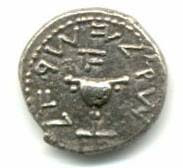As I noted before, in a letter to Tyler Cowen of the Volokh Conspiracy, public museums are likely not the best repositories of ancient artifacts, and certainly should not be granted a monopoly on possession.
The University of Melbourne, while developing its virtual Museum Project found the following in its archives/collections (read their full progress report here:
Coin discovery
20 ancient coins in an un-labeled plastic bag were discovered by the Curator of Collections, Heather Gaunt, while she was moving things from Old Physics to the new storage space in the Ian Potter Museum. The coins appear to be already in the database, listed as MES 23 - MES 42 in the 1971 Catalogue of Works of Art, and marked as missing when the coin database was started in 1996. They are all identical with MES 21 and MES 22, bronze, issued by Ptolemy X (117-81 B.C.)
Roman glass discovery
Two previously unknown pieces of Roman glass were found while collecting for photography the three pieces from the Kaye collection on display in the Lower East dining room at University house. Archival research revealed that one was bought by University House for the Ernst Matthaei Memorial Collection of Early Glass in 1984, the other was gift to the House in 1993 from Mr Paul Hackforth-Jones. The two new pieces have now been photographed and incorporated into the database.
They also report that many materials are missing or stolen from the museum.
Including:
One carton of antiquities remains missing.
Cross-referencing of archival papers with stocktake records and the databases, and some discreet personal enquiries, revealed that a number of objects now confirmed as missing were all stored in three containers. Two of these containers were found on 21 October 1998 (thanks to Robyn Sloggett in Conservation). The two containers found include 10 bronzes and an Iranian belt. But the third container never made it to Old Physics; or if it did, it went missing before photography of the collections commenced.
The bulk of the "Flinders Petrie" collection was in a cardboard carton, probably a bit larger than the usual Boreham's carton. These objects I personally removed from the drawers in the old department library on the 6th floor of Medley East and carried across to the Old Arts storeroom in June 1996. The FP objects include 5 ushabti, three figurines with inscriptions and two without, two other inscriptions, two tiles, two necklaces, two scarabs, a seal, a slingstone, some beads, a Hawk of Seker. Other items also packed into the same carton include a Roman brick and two ceramic antefix fragments, some terra sigillata, 10 small rectangular plaster casts, and a clay model of a "knitting Nancy".
Please give the matter some thought, and ask anyone who might have been in the laboratory or the Gallery storage area at the end of 1996.
Stolen vase.
One of our best decorated Greek vases, a hydria (MUV 40), was stolen in 1990. Images have now been made from the plates included by Peter Connor in his article "Replicas in Greek Vase-Painting: the Work of the Painter of Lourvre F6", BABesch 56 (1981) 37-44. Check out the images; and please keep an eye out for the vase itself.
Now I'm not saying the University of Melbourne is any better or worse than any other institution, and they likely are better, and they should be accoladed for at least publicly posting their losses and "discoveries". Their virtual museum is a great idea, making their collection or artifacts more accessible than having it be simply shelved in boxes in a storage area where it can be lost.
But can you imagine a private collector losing a bag of 20 ancient coins for a period of time of around twenty-seven years (1971-1998)? While it may happen, losing items seems to be a far more common occurrence for a museum.
It would be interesting to see the state of other museums' lost & found departments, not to mention their uncataloged collections.
Likewise, I wonder how many of the antiquities "lost" in the looting of the Baghdad Museum had already been lost, misappropriated or misplaced before the looting, and the looting will serve as a decent explanation to cover up the prior inventory losses?
Addition (Dec 16/03): I've added a post of another example of public museum mismanagement of historical artifacts here
Friday, December 12, 2003
Subscribe to:
Post Comments (Atom)

No comments:
Post a Comment